Workforce Management (WFM) software is a comprehensive tool designed to streamline and optimize the management of an organization’s workforce. It encompasses a range of functionalities aimed at improving efficiency, productivity, and overall employee satisfaction.

Implementation and Challenges
Implementing WFM software involves selecting the right system based on the organization’s size, industry, and specific needs. It requires careful planning, including setting clear goals, training staff, and integrating the software with existing systems such as payroll and HR platforms.
Challenges may include resistance to change from employees accustomed to manual processes, the need for ongoing maintenance and updates, and ensuring data security and privacy. Successful implementation hinges on effective change management strategies and ongoing support.
Workforce Management Software is a powerful tool for modern organizations seeking to optimize their workforce operations. By automating scheduling, time tracking, leave management, and compliance, these systems enhance efficiency, reduce costs, and improve employee satisfaction. With the ability to provide valuable analytics and insights, WFM software helps businesses make informed decisions and stay competitive in today’s dynamic market. Despite the challenges associated with implementation, the benefits of a well-integrated WFM system can significantly impact an organization’s overall success and productivity.
Workforcesoftware
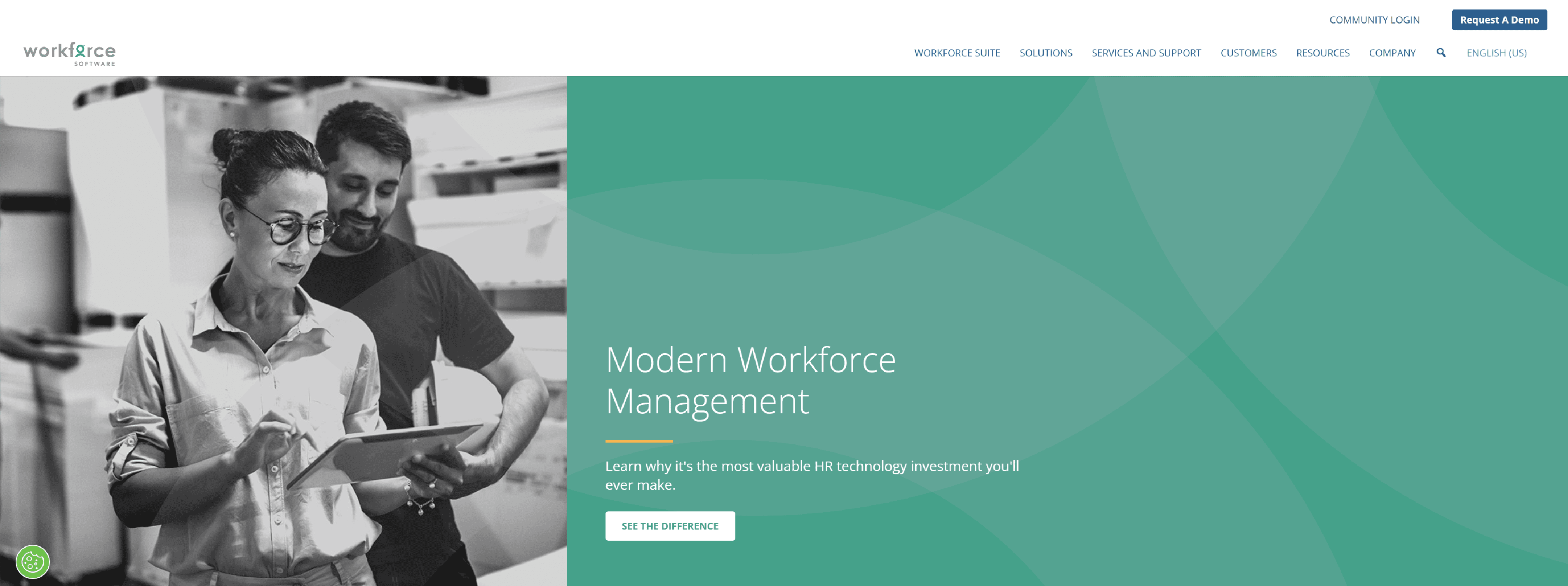
Workforcesoftware – workforce management software provides powerful, elegant, all-in-one solutions to meet your workforce management needs everywhere work happens.
- Modern Workforce Management
- The Value of Best-of-Breed
- Evaluate Your Options
- The ROI of Modern Workforce Management
- Build Trust With Your Employees
- Time and Attendance
- Absence, Leave, and Accommodations
- Scheduling
- Labor Forecasting
- Employee Experience
- Task Management
- Analytics and Insights
- Data Capture
- Employee Productivity and Labor Tracking
- Universal Compliance
Quinyx
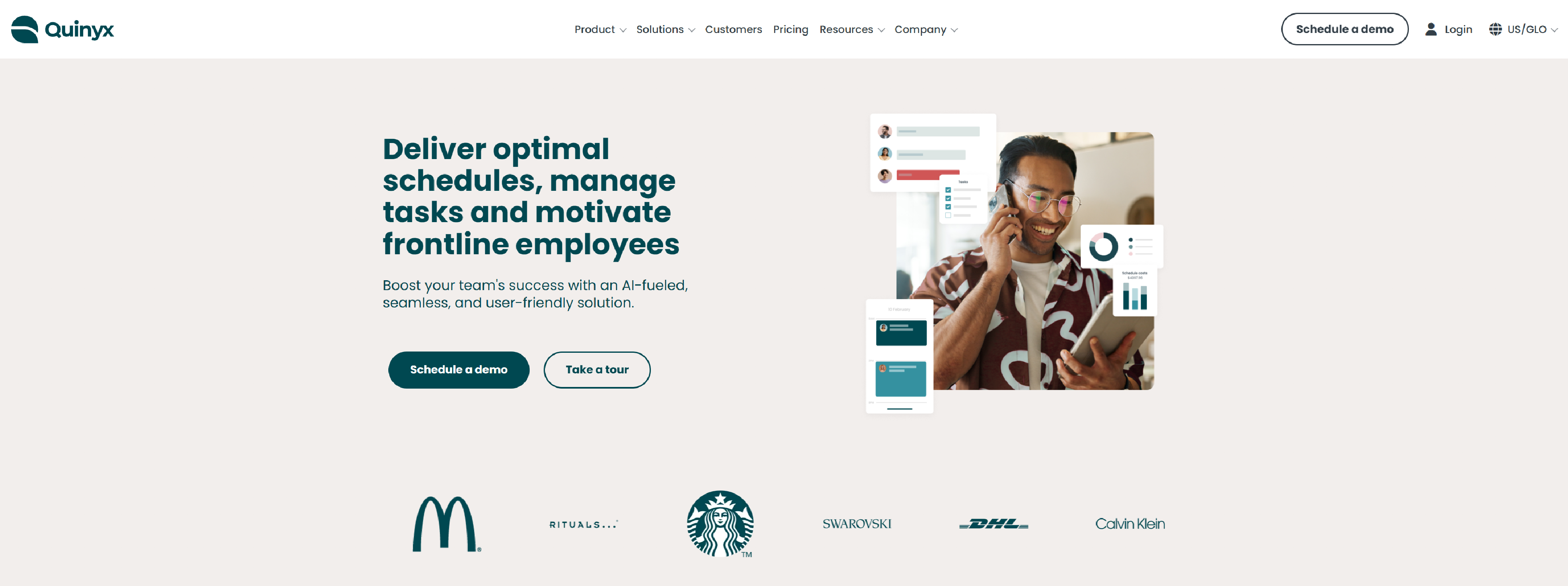
Save time, reduce costs and enjoy work with Quinyx, the cloud-based, mobile-first AI-powered Workforce Management Platform.
- Take your service, compliance and budget adherence to the next level with AI-driven Forecasting & Auto-Scheduling
- Save admin time and increase productivity with hassle-free scheduling, absence management and payrolling
- Transform employee engagement with our multi-communication app, tasks, surveys and rewards
Injixo
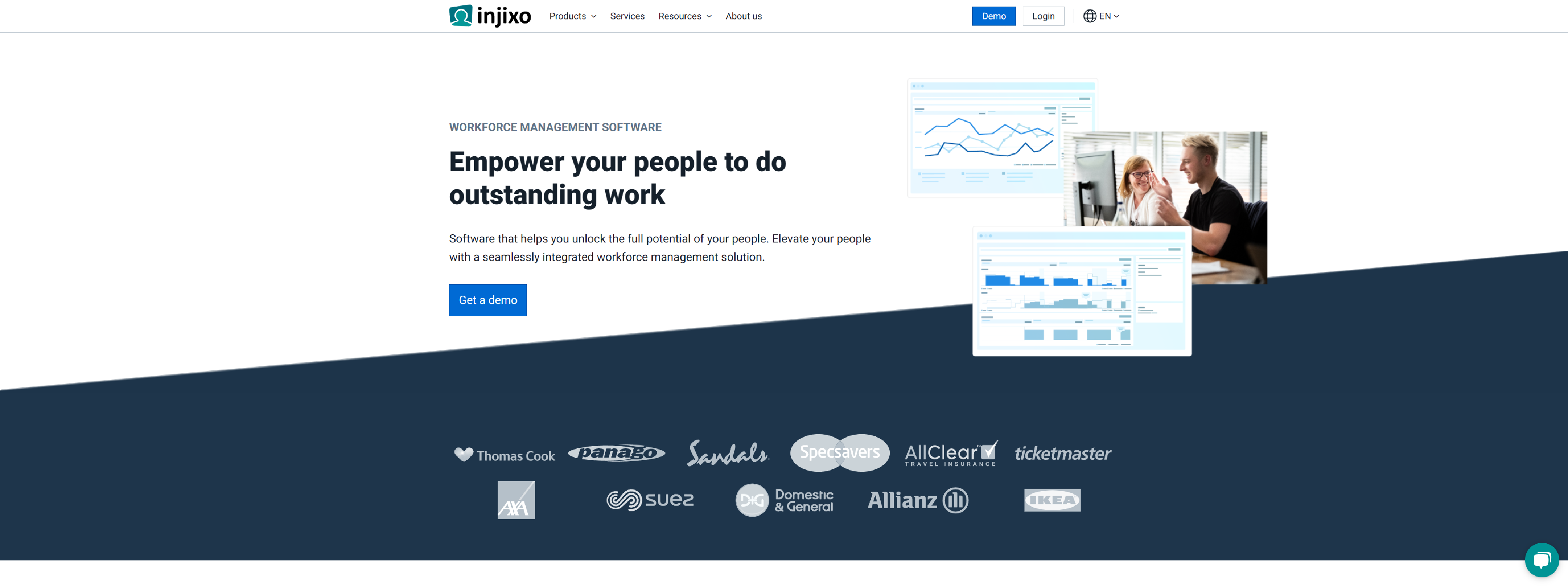
Injixo is a workforce management platform with all the software, integrations, and resources you need to optimize your WFM process from start to finish.
- Predict your short-, mid-, and long-term workload with machine learning that is always up to date
- Balance the requirements of your people with your business demands to create the best possible schedules
- Adapt your schedules to unforeseen events in real-time to secure your short-term business goals
Tamigo
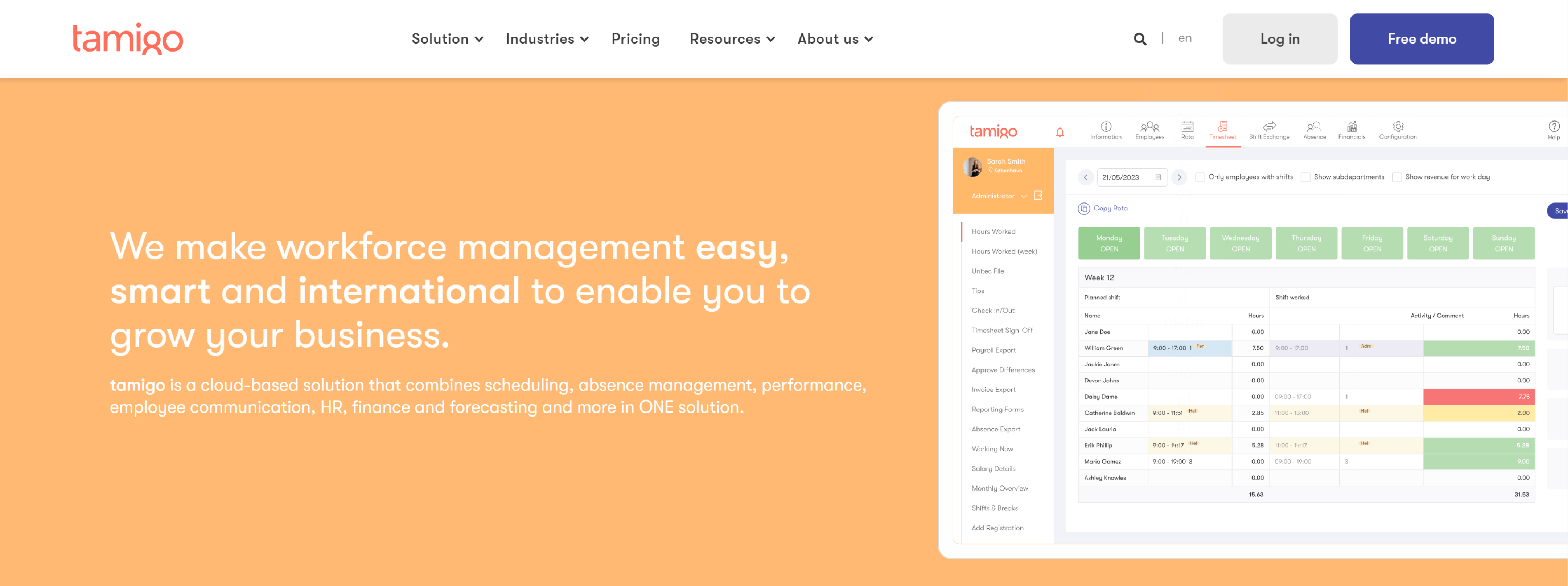
Tamigo is a cloud-based solution that combines scheduling, absence management, performance, employee communication, HR, finance and forecasting and more in ONE solution.
- Use KPIs to increase performance
- International benchmarking
- Meet national & international requirements
- Flexible standard solution
- Simple and transparent
- Easy integration with any other system
Clockify
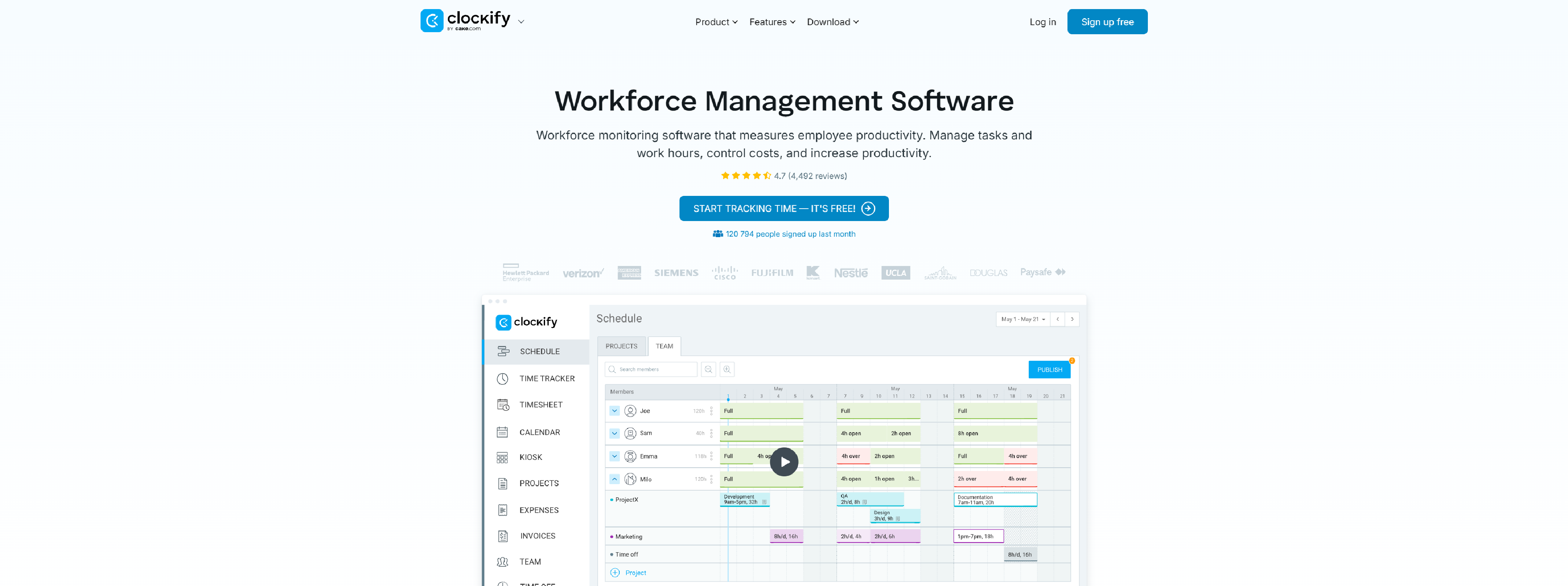
Clockify – a free workforce management software that helps you track attendance, manage work hours, and utilize every second of a workday.
- Start and stop timer as you work, or enter hours manually
- Log your weekly activities in less than a minute
- Clock in with your PIN code from a shared device
- Visualize your time and block out activities
- Track time using desktop and mobile app
- Connect Clockify with other apps
- See where you spend time and what your team is working on
- See who worked on what, how much money you earn, review your team’s time, and export the data
- See visited sites and what you’ve worked on
- Track time on projects, and keep an eye on progress and budget
- Invite your team to track time in your account
- Plan projects and visualize team’s capacity
- Track your team’s holidays and time off requests
- Officially approve your team’s and projects’ timesheets and expenses
- Record fixed-fees and other project expenses
- Issue invoices based on tracked time, expenses, and hourly rates
Activtrak

ActivTrak is a workforce analytics software-as-a-service platform that analyzes digital work activity data for insights to improve how people work – in office or remote.
- Gain a complete picture of work habits and potential blockers to success
- View organization-wide productivity trends for agile decision making
- Improve technology usage and workflows to optimize efficiencies
- Share weekly work insights with managers and employees to guide progress and growth
- Safeguard data privacy and security of customers and employees
Communitywfm
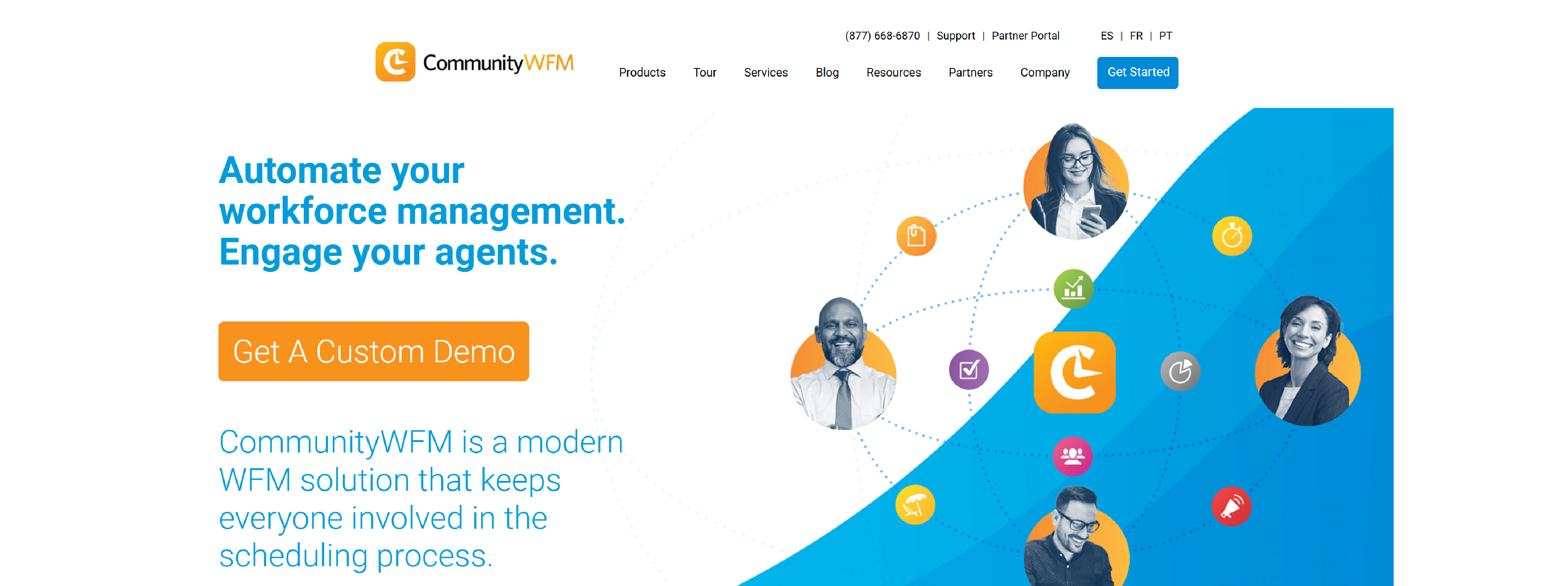
Automate your workforce management, engage agents, and optimize operations with contact center workforce management software from CommunityWFM.
- Designed by WFM professionals that understand the role of an analyst inside and out
- Proper workforce management is our sole focus, which is a key reason why customers like our modern software design and simplified solution
- Our steps-to-success onboarding process is unmatched in the industry
- Built to support a global contact center with multilingual capabilities in Canadian French, Brazilian Portuguese, and Mexican Spanish
Legion
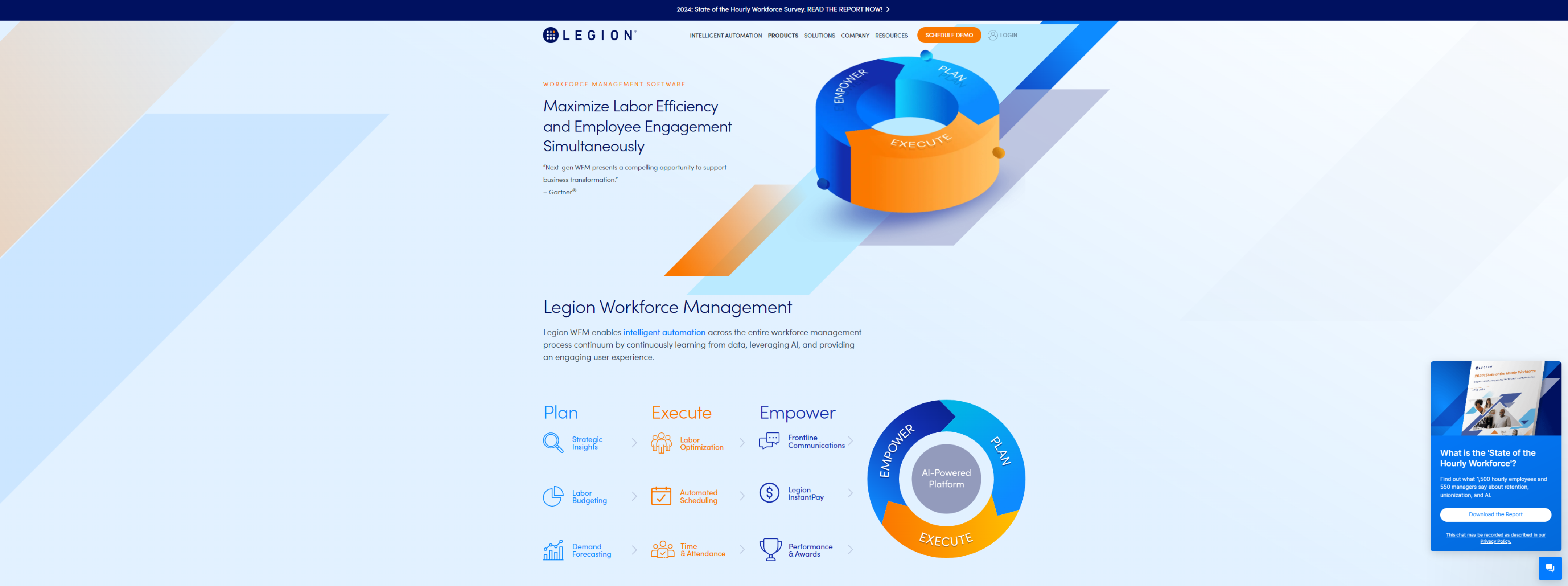
Legion’s industry-leading workforce management platform maximizes labor efficiency and employee engagement simultaneously.
- Enhance labor operations by automatically and accurately forecasting demand, while instantly creating the ideal schedule to manage labor costs effectively
- Equip managers with robust tools to oversee labor, automate daily scheduling and time tracking decisions, ensure compliance, and minimize overhead
- Improve the hourly employee experience with flexible, gig-like scheduling, immediate access to earned wages, and modern communication tools that help attract and retain top talent
- Companies using Legion WFM have realized a 13x return on investment, reduced scheduling time by 50%, and achieved a 96% alignment between business needs and employee preferences, revolutionizing both labor operations and the employee experience
Rotacloud
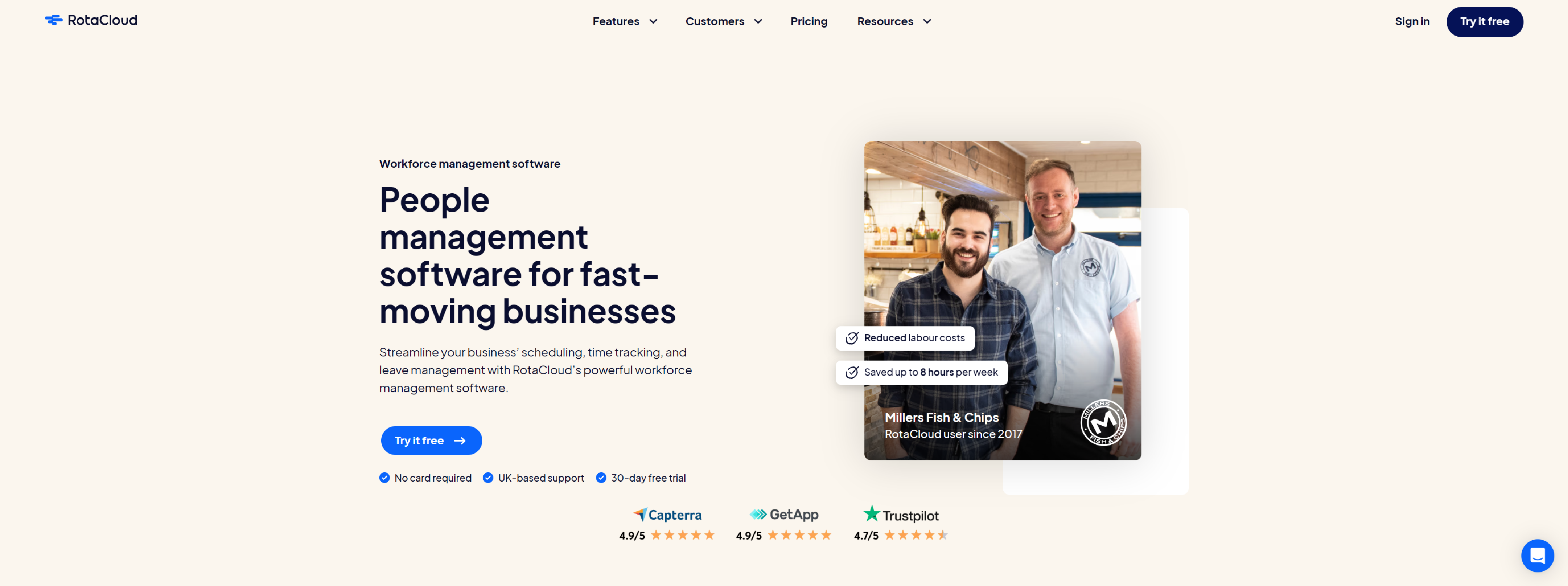
Streamline your business’ scheduling, time tracking, and leave management with RotaCloud’s powerful workforce management software.
- Build & amend complex rota patterns in seconds
- Pain-free payroll prep
- Automate leave management processes
- Track budgets & labour cost targets as you plan
- Store important employee documents securely
- Set access levels for employees & managers alike
Verint
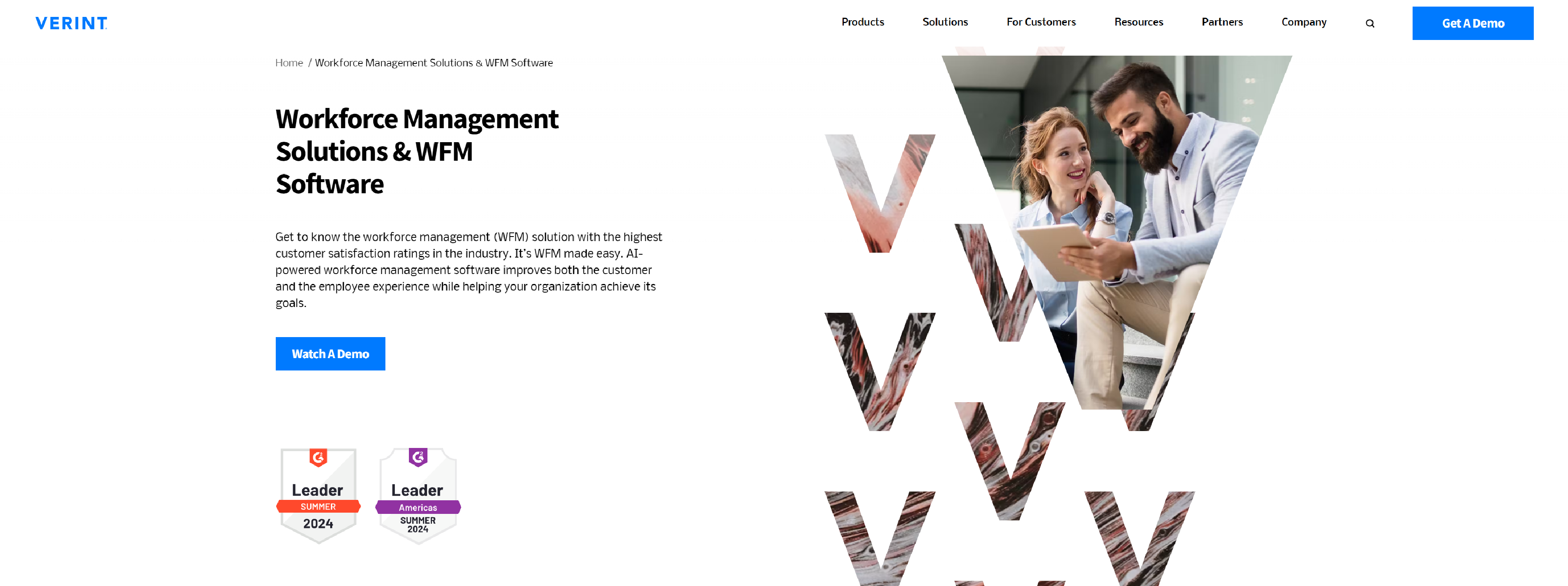
Verint – reduce the risk of overstaffing and shrinkage while automating WFM tasks, identifying time-off opportunities & providing employees with preferred schedules.
- Ensure the right people are scheduled at the right time
- Improve both customer and employee experience
- Give agents increased flexibility and work-life balance
- Gain greater insights
- Capitalize on the benefits of the cloud
How much do Workforce Management Software typically cost?
The cost of Workforce Management (WFM) software can vary widely depending on several factors, including the size of your organization, the features you need, and the pricing model of the software vendor.
1. Pricing Models
Subscription-Based Pricing
- Monthly or Annual Fees: Most WFM software vendors offer subscription-based pricing, which can be billed monthly or annually. The cost often depends on the number of users or employees.
- Cost Range: For small to mid-sized businesses, subscription fees typically range from $2 to $10 per user per month. Larger organizations with more complex needs might pay $10 to $25 per user per month or more.
Perpetual Licensing
- One-Time Fee: This model involves a one-time payment for a license to use the software indefinitely. It may come with additional costs for maintenance and support.
- Cost Range: Perpetual licenses can cost from $10,000 to $100,000 or more, depending on the software’s features and the number of users.
Usage-Based Pricing
- Pay-As-You-Go: Some vendors offer pricing based on usage metrics such as the number of employees tracked or the volume of transactions.
- Cost Range: Usage-based pricing can vary widely. For example, costs might range from a few cents per transaction to higher fees based on specific usage thresholds.
2. Cost Factors
Number of Users
- Small Businesses: For smaller companies, the cost is often lower due to fewer users. Subscription fees might be more affordable in this case.
- Large Organizations: Larger organizations with more users will typically face higher costs, but they may also benefit from volume discounts.
Features and Modules
- Basic Features: Basic plans usually include core functionalities like scheduling and time tracking.
- Advanced Features: Additional features such as advanced analytics, performance management, or compliance tools can increase the cost. Some software providers offer these features as add-ons or in higher-tier packages.
Customization and Integration
- Customization: Customizing the software to fit specific needs or integrating it with existing systems (like HRIS or payroll) can add to the overall cost.
- Integration Costs: Integration fees might range from a few thousand dollars to tens of thousands, depending on the complexity.
Support and Training
- Basic Support: Many vendors include basic support in their pricing.
- Premium Support: Enhanced support options, such as dedicated account managers or 24/7 support, might incur additional fees.
- Training: Training costs can vary based on the depth and format of the training provided. Some vendors include basic training in the subscription, while others may charge separately.
3. Example Pricing Scenarios
Small Business
- Subscription Model: A small business with 20 users might pay around $500 to $1,000 per month for a subscription-based WFM solution, depending on the features required.
- One-Time License: A perpetual license for a small business might cost between $20,000 and $50,000, including basic support and initial training.
Mid-Sized Business
- Subscription Model: A mid-sized business with 100 users might expect to pay between $2,000 and $5,000 per month.
- One-Time License: For a perpetual license, costs could range from $50,000 to $150,000.
Large Enterprise
- Subscription Model: Large enterprises with hundreds or thousands of users may face costs ranging from $10,000 to $50,000 per month or more.
- One-Time License: Perpetual licenses for large organizations can exceed $100,000 and may approach $500,000 or more, depending on the scale and customization.
The cost of Workforce Management software can vary significantly based on factors such as the number of users, features required, and the chosen pricing model. For a precise estimate, it’s best to request quotes from vendors and consider the total cost of ownership, including initial costs, ongoing fees, and any additional expenses for customization, integration, and support.
How to Choose Workforce Management Software
Choosing the right Workforce Management (WFM) software for your organization is crucial for optimizing operations, improving efficiency, and enhancing employee satisfaction. Here’s a step-by-step guide to help you make an informed decision:
1. Assess Your Needs
- Identify Requirements: Start by identifying your specific needs. Consider the size of your organization, the complexity of your workforce, and the challenges you currently face. Common needs include scheduling, time and attendance tracking, leave management, compliance, and performance management.
- Define Objectives: Outline what you want to achieve with WFM software. Whether it’s reducing labor costs, improving scheduling efficiency, or enhancing compliance, having clear objectives will guide your selection process.
2. Evaluate Key Features
- Scheduling and Shift Planning: Look for software that offers advanced scheduling capabilities, including shift planning, coverage optimization, and automated alerts for scheduling conflicts.
- Time and Attendance: Ensure the software provides accurate time tracking, supports various clocking methods (e.g., biometric, mobile apps), and integrates seamlessly with payroll systems.
- Leave Management: Choose a system that simplifies leave requests and approvals, tracks different types of leave, and ensures compliance with leave policies.
- Compliance Management: Ensure the software can handle compliance with labor laws, track working hours, manage overtime, and generate necessary reports.
- Performance Management: If performance tracking is important, select software with tools for setting goals, conducting reviews, and analyzing employee performance.
- Analytics and Reporting: Look for robust analytics and reporting features that offer insights into labor costs, productivity, attendance trends, and other key metrics.
3. Consider Integration Capabilities
- Existing Systems: Evaluate how well the WFM software integrates with your existing systems such as payroll, HR, and ERP platforms. Seamless integration reduces manual data entry and ensures consistency across systems.
- Future Scalability: Ensure the software can scale with your organization’s growth. Consider if it supports additional features or modules that you might need in the future.
4. User Experience and Usability
- Ease of Use: The software should be user-friendly for both managers and employees. A complicated system can lead to frustration and reduced adoption rates.
- Training and Support: Check if the provider offers training resources, support services, and user guides. Good customer support is essential for addressing issues and maximizing the software’s potential.
5. Cost and Budget
- Pricing Models: Understand the pricing structure of the software. Costs may include licensing fees, implementation charges, training, and ongoing support. Some software solutions offer subscription-based pricing, while others might have a one-time fee.
- Return on Investment: Consider the potential ROI by evaluating how the software can reduce labor costs, increase productivity, and improve compliance. A higher upfront cost may be justified by long-term savings and benefits.
6. Vendor Reputation and Reviews
- Reputation: Research the vendor’s reputation in the market. Look for reviews, case studies, and testimonials from other organizations in your industry.
- References: Ask the vendor for references or case studies from similar-sized organizations or those with similar needs to see how the software has performed in real-world scenarios.
7. Security and Compliance
- Data Security: Ensure the software provider has robust security measures in place to protect sensitive employee data. Check for features like encryption, secure access controls, and data backup.
- Regulatory Compliance: Verify that the software complies with relevant regulations and standards, such as GDPR for data protection or industry-specific compliance requirements.
8. Trial and Demonstration
- Demos: Request a demo or trial version of the software to evaluate its functionality and ease of use. This hands-on experience can help you assess how well the software meets your needs.
- User Feedback: Involve key stakeholders in the evaluation process, including HR, payroll, and operational managers, to gather feedback on the software’s suitability and usability.
9. Implementation and Support
- Implementation Plan: Review the vendor’s implementation plan to ensure it aligns with your timeline and resources. A structured implementation process helps in a smooth transition.
- Ongoing Support: Evaluate the level of ongoing support offered, including software updates, troubleshooting, and customer service.
Choosing the right Workforce Management software involves a thorough assessment of your organization’s needs, evaluating key features, and considering integration capabilities, usability, cost, and vendor reputation. By taking a strategic approach and involving key stakeholders in the decision-making process, you can select a solution that not only meets your current needs but also supports your organization’s growth and future requirements.
Workforce Management Software: Frequently Asked Questions
When considering or implementing Workforce Management (WFM) software, you might have several questions about its features, benefits, integration, and other aspects.
What is Workforce Management Software?
Workforce Management (WFM) software is a tool designed to help organizations manage and optimize their workforce. It includes features for scheduling, time and attendance tracking, leave management, performance management, and compliance. The goal is to streamline workforce-related processes, improve efficiency, and reduce operational costs.
How does WFM software improve scheduling?
WFM software uses algorithms and rules to create efficient schedules based on employee availability, skills, and labor laws. It can automatically handle shift swaps, notify employees of schedule changes, and optimize coverage to meet business needs.
Can WFM software integrate with existing systems?
Yes, most WFM software can integrate with other systems such as Human Resources Information Systems (HRIS), payroll systems, and Enterprise Resource Planning (ERP) platforms. Integration ensures data consistency, reduces manual entry, and streamlines operations.
How does WFM software handle compliance with labor laws?
WFM software helps manage compliance by tracking work hours, breaks, and overtime in accordance with labor laws. It can generate reports and alerts to ensure adherence to legal requirements, reducing the risk of compliance issues and penalties.
Can WFM software be used for remote or flexible work arrangements?
Yes, many WFM solutions support remote and flexible work arrangements by allowing employees to clock in and out via mobile apps or web portals. The software can handle varying schedules and track productivity regardless of where employees are working.
How does WFM software handle data security?
Reputable WFM software providers implement robust security measures, including data encryption, secure access controls, and regular backups. It is important to ensure that the software complies with data protection regulations and that the vendor follows best practices for data security.
What kind of support is available for WFM software?
Support options vary by vendor but typically include customer service via phone, email, or chat, as well as online resources such as user manuals, FAQs, and video tutorials. Some vendors also offer dedicated account managers or consultants to assist with ongoing support and optimization.
Is WFM software suitable for all types of businesses?
WFM software is versatile and can be tailored to suit various industries and business sizes. However, the specific features and functionalities required may vary depending on the nature of the business, the size of the workforce, and industry-specific needs.
What is the typical cost structure for WFM software?
Cost structures vary and can include one-time licensing fees, subscription-based pricing, or usage-based models. Additional costs may be associated with implementation, training, and ongoing support. It’s important to consider the total cost of ownership when evaluating options.
How often does WFM software need to be updated or upgraded?
Software updates and upgrades are typically released regularly to introduce new features, improve security, and fix bugs. The frequency and nature of updates depend on the vendor’s release cycle and the specific software version you are using. Most vendors provide information on available updates and how they impact your system.
By understanding these frequently asked questions and carefully planning the integration process, you can ensure that the software meets your organization’s needs and enhances overall efficiency.